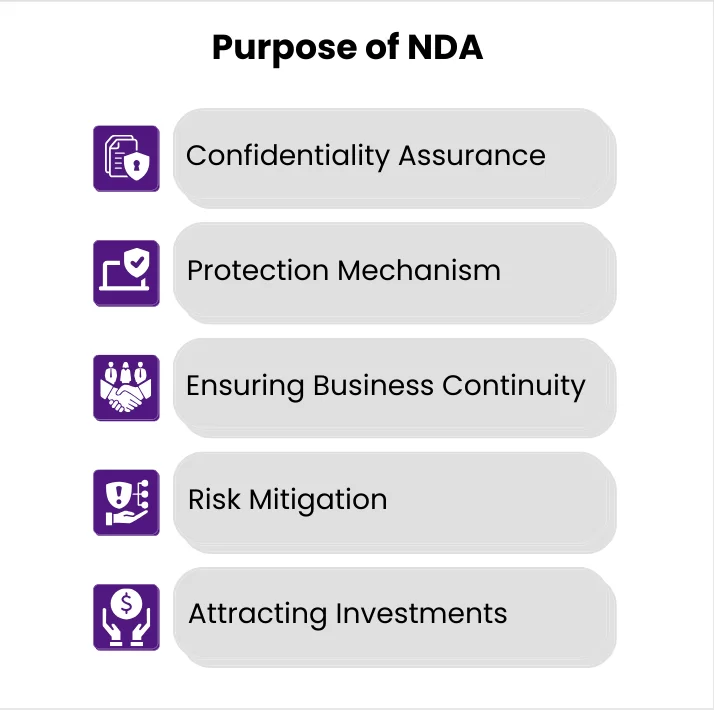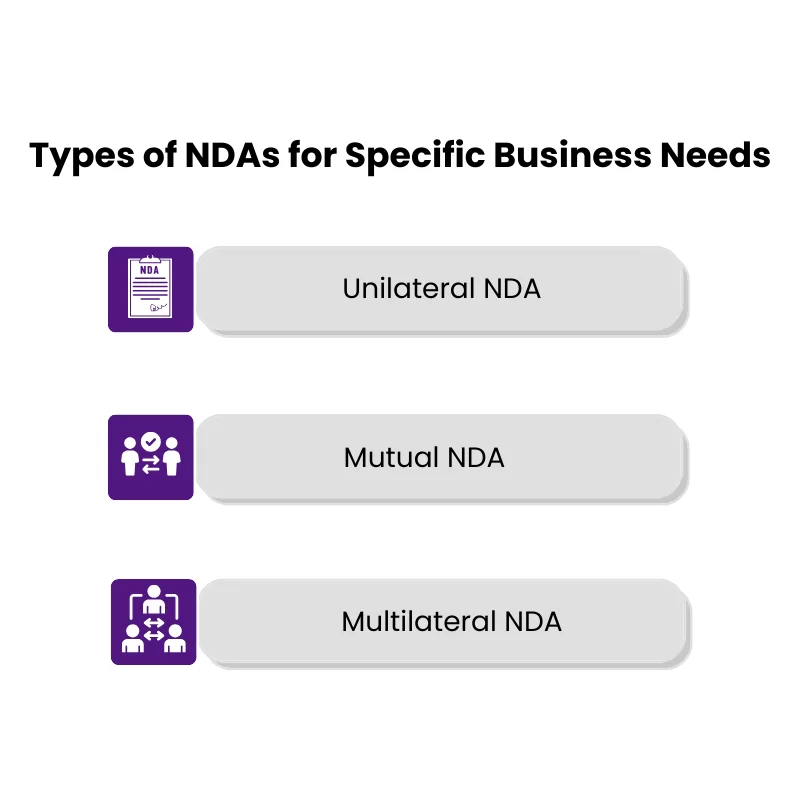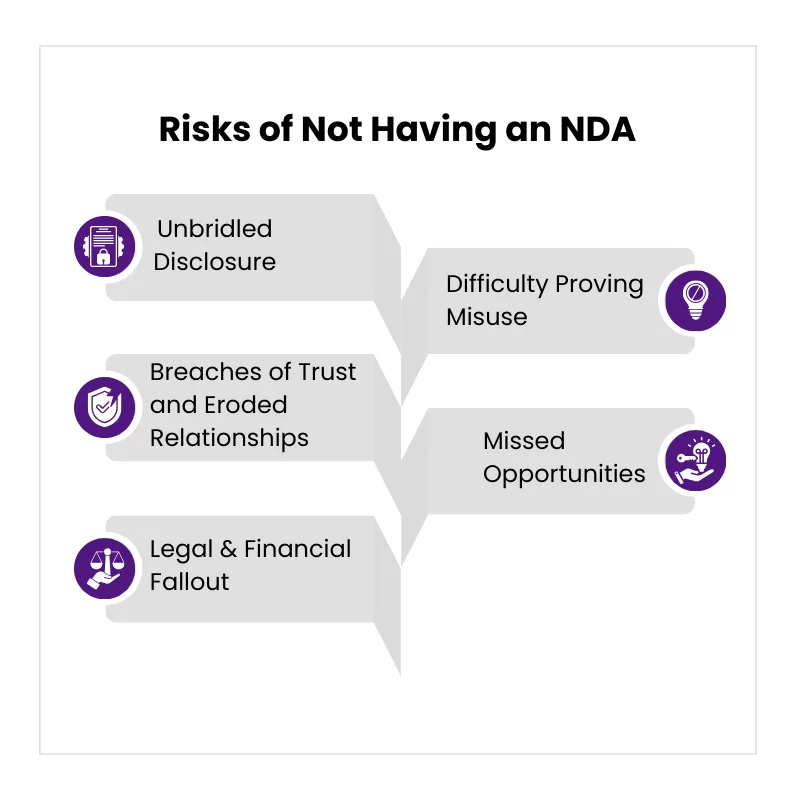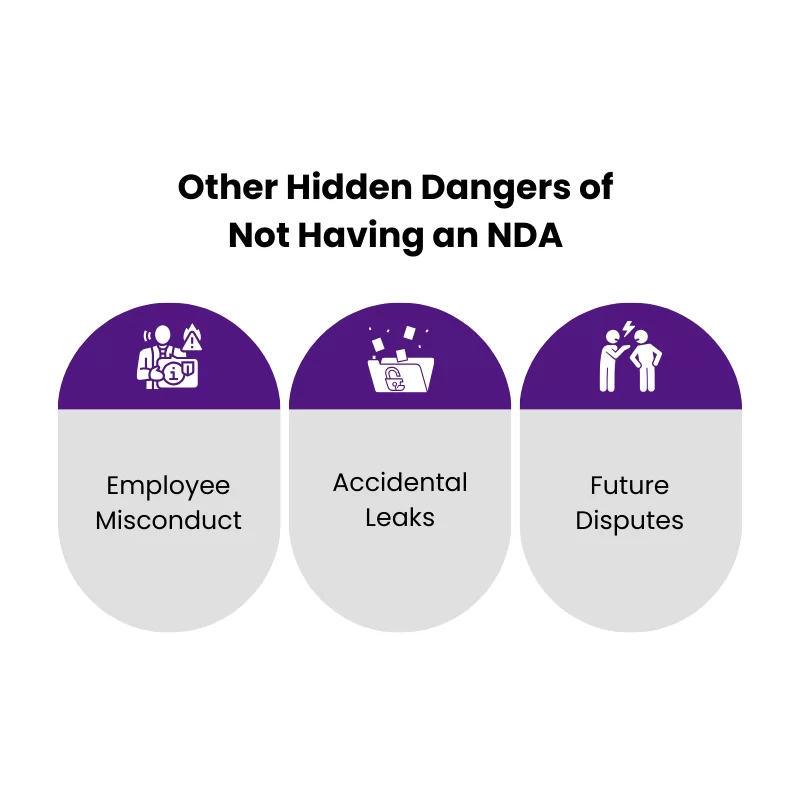If you’re in a hurry or may not want to read through the whole blog or want immediate access to the ‘Non-Disclosure Agreement (NDA) Template’, get the free download from here. However, we highly recommend reading this exhaustive guide compiled by us throwing light on various aspects of an NDA as listed below.
Non-Disclosure Agreements (NDAs) stand as indispensable tools for businesses, especially small and medium-sized businesses (SMBs), ensuring the protection of sensitive information.
This comprehensive guide aims to delve into the multifaceted aspects of NDAs that includes:
- Purpose of NDA
- Types of NDA For Specific Business Needs
- Business Transactions where NDAs are Applicable
- Why NDA is Crucial for Your Business?
- Essential Functions of an NDA
- How to Create an NDA?
- Effectively Enforcing an NDA
- Consequences of Breaking an NDA
- Risks of Not Having an NDA
- How Vyapi can Help?
- Case Studies
Without much ado, let’s dive in!
Purpose of NDA
Serving a pivotal role in business transactions by establishing a confidential relationship between parties involved the primary purpose of an NDA is twofold: confidentiality and protection.

Let’s delve into a detailed exploration of the profound purpose that NDAs serve:
#1. Confidentiality Assurance
- Information Privacy: NDAs create a confidential environment wherein one or both parties have a legal duty not to share sensitive information. This confidentiality extends to a broad spectrum of proprietary data, ranging from trade secrets and business plans to financial information.
- Defining What is Confidential: NDAs explicitly outline what constitutes confidential information, bringing clarity to the scope of protected data. This classification prevents misunderstandings and sets the boundaries for information that should not be disclosed.
#2. Protection Mechanism
- Legal Framework: NDAs establish a legal framework to protect ideas, innovations, and sensitive data from being divulged to unauthorized parties. This legal shield ensures that the party receiving confidential information is bound by the agreement and can face legal consequences for breaches.
- Preventing Unauthorized Use: An NDA acts as a deterrent against the unauthorized use or disclosure of confidential information. The legal ramifications for breaking the agreement serve as a powerful incentive for parties to adhere to the terms.
#3. Ensuring Business Continuity
- Maintaining Competitive Edge: For businesses, especially Small and Medium-sized Businesses (SMBs), protecting proprietary information is crucial for maintaining a competitive edge. NDAs prevent competitors or unauthorized entities from gaining access to critical business insights.
- Fostering Trust in Relationships: : In various business relationships, such as partnerships, joint ventures, or collaborations, NDAs foster trust. Signing an NDA demonstrates a commitment to confidentiality, laying the foundation for a relationship built on trust and reliability.
#4. Risk Mitigation
- Preventing Intellectual Property Theft: NDAs play a crucial role in preventing intellectual property theft. By making it illegal for recipients to use or disclose confidential information without permission, businesses can safeguard their innovations and creative works.
- Legal Recourse for Breaches: NDAs provide a clear path for legal recourse in case of breaches. This includes the right to seek damages, injunctive relief, or pursue alternative dispute resolution methods, offering a comprehensive approach to address violations.
#5. Attracting Investments
- Investor Confidence: Investors are more likely to invest in businesses that take proactive measures to protect their confidential information. NDAs signal to investors that the business is committed to safeguarding its intellectual property, instilling confidence in the investment potential.
- Facilitating Growth: The protection provided by NDAs facilitates business growth by creating a secure environment for collaboration, partnerships, and negotiations. This, in turn, attracts the capital needed for expansion and development.
In essence, the purpose of an NDA goes beyond a mere legal formality; it becomes a strategic instrument for businesses to navigate the complex landscape of information exchange, innovation, and collaboration.
By upholding confidentiality, ensuring legal protection, and mitigating risks, NDAs emerge as indispensable tools for SMBs aiming for sustained success in a competitive business environment.
Types of NDA For Specific Business Needs

Non-Disclosure Agreements (NDAs) are versatile instruments, and their effectiveness lies in their ability to adapt to different scenarios. There are primarily three main types of NDAs, each serving distinct purposes based on the nature of the information exchange. Let’s explore these types in detail:
#1. Unilateral NDA
- Definition: Unilateral NDAs, also known as one-way NDAs, involve one party (the disclosing party) sharing confidential information with another party (the recipient). The recipient agrees not to disclose or use the provided information for their benefit or share it with third parties.
- Example Scenario: When a company shares proprietary information with a consultant or a vendor, a unilateral NDA ensures that the recipient is legally bound to keep the information confidential.
- Key Characteristics
- One-way protection: The disclosing party is the sole beneficiary of confidentiality.
- Common in employer-employee relationships: Employment contracts often include unilateral NDAs to protect the employer’s trade secrets and sensitive business information.
#2. Mutual NDA
- Definition: Mutual NDAs, also known as two-way NDAs, involve a reciprocal agreement between two parties. Both parties exchange confidential information and agree not to disclose or use the other party’s information for unauthorized purposes.
- Example Scenario: In a business collaboration or partnership, where both entities need to share proprietary information for mutual benefit, a mutual NDA ensures a balanced protection mechanism.
- Key Characteristics
- Reciprocal protection: Both parties are bound by confidentiality obligations.
- Common in collaborations: Businesses entering joint ventures, collaborations, or exploring partnerships often opt for mutual NDAs to safeguard shared information.
#3. Multilateral NDA
- Definition: While less common, multilateral NDAs involve three or more parties. This type is employed when several entities need to share confidential information in a group setting.
- Example Scenario: In complex business transactions involving multiple stakeholders, each party may contribute unique confidential information, and a multilateral NDA helps regulate the confidentiality obligations among all parties.
- Key Characteristics
- Involves multiple parties: Applicable when there is a need for collective confidentiality.
- Complex transactions: Multilateral NDAs are more common in intricate business dealings where various entities contribute essential information.
Choosing between unilateral and mutual NDAs depends on the specifics of the business arrangement and the nature of the information exchange. Unilateral NDAs are suitable when one party predominantly discloses information, such as in employer-employee relationships.
On the other hand, mutual NDAs are apt for scenarios where a reciprocal exchange of confidential information is essential, fostering a balanced and mutually beneficial relationship.
Understanding the types of NDAs allows businesses to tailor their confidentiality agreements to the unique demands of each situation, creating a legal framework that aligns with the dynamics of their information-sharing endeavors.
Business Transactions where NDAs are Applicable
Non-Disclosure Agreements (NDAs) play a crucial role in various business transactions, providing a legal framework to protect sensitive information exchanged between parties.

The application of NDAs extends across a spectrum of business interactions, ensuring confidentiality and mitigating risks in the following scenarios:
Product Development and Launch
When a company is in the early stages of developing a new product, it may engage with external consultants, manufacturers, or collaborators. An NDA ensures that the innovative concepts, designs, and proprietary information related to the product remain confidential during the development phase.
Employee Onboarding and Training
When new employees join a company, they often gain access to proprietary information, trade secrets, and internal processes. An NDA safeguards the organization by prohibiting employees from disclosing or utilizing confidential information for personal gain.
Partnerships and Collaborations
Businesses entering into partnerships, collaborations, or joint ventures often share strategic plans, financial data, or proprietary methodologies. A mutual NDA establishes a trust framework, allowing both parties to share and receive confidential information without fear of unauthorized disclosure.
Mergers and Acquisitions (M&A)
During M&A negotiations, companies exchange extensive financial data, customer lists, and operational insights. NDAs are vital in these high-stakes transactions to ensure that sensitive information remains confidential, preventing any adverse impact on the deal or the involved parties.
Supplier and Vendor Relationships
Companies regularly engage with suppliers and vendors, sharing details about their supply chain, pricing structures, and product specifications. Unilateral NDAs help protect the disclosing party’s trade secrets, ensuring that the supplier or vendor does not exploit or share the provided information.
Investor Discussions and Due Diligence
Startups seeking investment often need to disclose sensitive financial data, business plans, and projections to potential investors. An NDA adds a layer of protection during these discussions, assuring startups that their confidential information won’t be misused.
Client Onboarding and Service Provision
Service providers, such as consulting firms or agencies, may enter into NDAs with clients to safeguard proprietary methodologies, client lists, and business strategies. This ensures that confidential information shared during the engagement remains protected.
Research and Development Collaborations
Companies engaged in joint research and development projects may share scientific findings, experimental data, and technological insights. A well-crafted NDA is essential to foster collaboration while maintaining confidentiality.
Litigation and Legal Consultations
When seeking legal advice or involved in litigation, companies may need to disclose sensitive information to their legal representatives. Attorney-client privilege extends confidentiality, but NDAs can provide an additional layer of protection, especially when multiple parties are involved.
Strategic Alliances and Licensing Agreements
Businesses forming strategic alliances or licensing intellectual property may share critical information to facilitate the partnership. NDAs ensure that proprietary information remains confidential, protecting the interests of both parties.
Understanding the diverse scenarios where NDAs are applicable empowers businesses to navigate these interactions with confidence.
Whether in the realm of innovation, collaboration, or strategic negotiations, NDAs serve as essential tools for preserving confidentiality and fostering trust in the dynamic landscape of business transactions.
Why NDA is Crucial for Your Business?
In the intricate web of modern business dealings, the Non-Disclosure Agreement (NDA) emerges as a linchpin, offering vital protective measures and strategic advantages.

The significance of NDAs for businesses is multi-fold, with far-reaching implications for safeguarding proprietary information, fostering trust, and mitigating potential risks:
Preserving Confidentiality
- Strategic Advantage: NDAs grant businesses a strategic edge by ensuring that confidential information crucial to their operations, be it trade secrets, proprietary technologies, or upcoming product launches, remains shielded from unauthorized disclosure.
- Competitive Edge: In competitive industries, where innovative ideas and unique processes define success, NDAs act as a fortress, preventing rivals from gaining insights that could compromise a company’s competitive edge.
Building Trust in Collaborations
- Facilitating Open Communication: NDAs provide a foundation of trust, allowing businesses to engage in open and honest collaborations without the fear of sensitive information being misused. This is particularly crucial in partnerships, joint ventures, and other collaborative endeavors.
- Competitive Edge: When companies are assured that their groundbreaking ideas are protected, they are more inclined to share innovative concepts, fostering an environment conducive to groundbreaking developments and advancements.
Mitigating Risks in Transactions
- Mergers and Acquisitions (M&A): NDAs play a pivotal role in M&A transactions by safeguarding the confidentiality of financial data, operational insights, and other critical information. This ensures that the due diligence process is conducted with integrity and confidentiality.
- Investor Relations: Businesses seeking investments share detailed financials and business plans with potential investors. NDAs instill confidence in investors, assuring them that their scrutiny won’t result in the exposure of sensitive information.
Employee Relations and Retention
- Employee Trust NDAs reinforce trust between employers and employees, assuring the latter that sensitive information shared during employment will remain confidential. This is especially important in industries where employee turnover is common.
- Retaining Intellectual Capital: Businesses invest heavily in training and developing their workforce. NDAs protect this intellectual capital by preventing departing employees from using or disclosing proprietary information in their future endeavors.
Legal Recourse in Case of Breach
- Enforceable Legal Protection: NDAs create a legally binding agreement between parties, establishing clear expectations and consequences in case of breach of contracts. This legal recourse is essential for businesses seeking to protect their interests in the event of unauthorized disclosures.
- Competitive Edge: When companies are assured that their groundbreaking ideas are protected, they are more inclined to share innovative concepts, fostering an environment conducive to groundbreaking developments and advancements.
Client and Vendor Relationships
- Client Confidence: Clients often share sensitive information with service providers, from marketing strategies to upcoming product launches. NDAs enhance client confidence by assuring them that their proprietary information is in safe hands.
- Vendor Trust: For businesses engaged with vendors and suppliers, NDAs ensure that trade secrets, pricing models, and other confidential information are not exploited or shared with competitors.
Innovation and Research Collaborations
- Research Protection: In industries driven by innovation, such as technology and pharmaceuticals, NDAs are indispensable. They safeguard research findings, experimental data, and technological advancements, fostering an environment conducive to further innovation.
- Collaboration Assurance: Research collaborations involve the exchange of critical information. NDAs create a framework that enables organizations to collaborate confidently, knowing that their intellectual property is secure.
Market Expansion and Alliances
- Global Ventures: For businesses eyeing global expansion, NDAs are vital when entering new markets or forming alliances with international partners. They provide a standardized mechanism for protecting sensitive information across borders.
- Strategic Alliances: NDAs facilitate the sharing of critical information in strategic alliances without the fear of exploitation. This is essential for businesses seeking to expand their market presence through collaborations.
Customer Trust and Data Protection
- Data Security: In the digital age, where customer data is an asset, NDAs play a role in assuring customers that their sensitive information will be handled with utmost confidentiality and won’t be shared without consent.
- Privacy Compliance: Businesses dealing with personal or sensitive data must adhere to privacy regulations. NDAs demonstrate a commitment to privacy compliance by establishing protocols for the handling of confidential information.
Brand Reputation Management
- Avoiding Scandals: Public scandals involving data breaches or unauthorized disclosures can tarnish a brand’s reputation irreparably. NDAs serve as a proactive measure to prevent such incidents, safeguarding not only information but also the brand’s image.
- Ethical Business Practices: Demonstrating a commitment to ethical business practices, including the protection of confidential information, enhances a company’s standing in the eyes of stakeholders and the public.
In essence, NDAs are indispensable tools that empower businesses to navigate the complex landscape of modern commerce.
From preserving the sanctity of trade secrets to fostering collaborative innovation, the importance of NDAs in fortifying business interests cannot be overstated.
As guardians of confidentiality, these agreements contribute significantly to creating a secure and trustworthy environment for businesses to thrive.
Essential Functions of an NDA
The essential functions of an NDA are meticulously crafted to create a legal framework that not only defines the boundaries of confidentiality but also establishes the obligations and consequences in the event of a breach.

Let’s delve into the core functions that make NDAs indispensable in the realm of business transactions:
Identification of Parties
NDAs clearly specifies the entities involved in the NDA, designating the disclosing party (provider of sensitive information) and the recipient (party gaining access to confidential information).
It establishes a foundational understanding of the roles and responsibilities of each party, ensuring that there is no ambiguity regarding who is bound by the agreement.
Definitions
It precisely outlines the types of information considered confidential, eliminating ambiguity and potential misunderstandings.
NDA provides a comprehensive understanding of what falls under the umbrella of confidential information, including trade secrets, financial data, intellectual property, and any other proprietary materials.
Obligations
NDA clearly articulates the responsibilities of both the disclosing and receiving parties concerning the handling, use, and protection of confidential information.
Sets expectations for how the recipient should treat the disclosed information, imposing a legal duty to maintain confidentiality and use the information only for agreed-upon purposes.
Scope
NDA defines the limits of the confidentiality agreement, specifying the exact information covered by the NDA.
It prevents misunderstandings by explicitly stating what is considered confidential, leaving no room for interpretation or inadvertent breaches.
Time Frame
NDA establishes the duration for which the confidentiality obligations remain in force.
NDA prevents indefinite restrictions on the use of information, ensuring that the agreement has a defined lifespan, and that confidential information is not bound indefinitely.
Return of Information
NDA outlines the procedures for returning or destroying confidential information at the conclusion of the business relationship.
NDA ensures that, once the purpose of sharing information is fulfilled, the recipient confirms the return or destruction of all confidential materials, reducing the risk of unintentional breaches.
Exclusions
NDA enumerates specific categories of information that are not considered confidential and, therefore, not subject to the agreement.
NDA provides clarity on what information can be freely used or disclosed, preventing unnecessary constraints on non-confidential or publicly known information.
Remedies
NDA specifies the legal consequences in the event of a breach, outlining the remedies available to the disclosing party.
It acts as a deterrent against breaches by clearly communicating the potential legal and financial repercussions, including injunctive relief, monetary damages, and other remedies.
Confidentiality During Legal Proceedings
NDA addresses how confidential information will be treated if it is required to be disclosed during legal proceedings.
NDA establishes a framework for handling legal requests, ensuring that confidential information remains protected even in the face of legal obligations.
Governing Law and Jurisdiction
NDA specifies the laws and jurisdiction under which the NDA will be interpreted and enforced.
NDA provides clarity on the legal framework governing the agreement, guiding parties on where and how disputes will be resolved.
No License or Transfer of Rights
NDA does not confer any rights, licenses, or ownership of the confidential information to the receiving party.
NDA prevents misconceptions regarding the transfer of intellectual property rights and emphasizes that the agreement is solely for the purpose of maintaining confidentiality.
Mutual or Unilateral Designation
It helps in specifying whether the NDA is mutual (both parties share confidential information) or unilateral (only one party discloses).
NDA defines the nature of the relationship, establishing whether both parties have reciprocal confidentiality obligations or if only one party is bound.
In essence, the essential functions of an NDA form a comprehensive framework that not only safeguards the confidentiality of sensitive information but also provides a roadmap for legal recourse in the face of breaches.
These functions collectively contribute to the effectiveness of NDAs in facilitating secure and trustworthy business transactions, where confidentiality is paramount.
How to Create an NDA?
Creating a robust Non-Disclosure Agreement (NDA) involves careful consideration of key elements to ensure clarity, enforceability, and comprehensive coverage of confidential information.

Here is a detailed guide on how to create an effective NDA:
Define the Parties
Clearly identify the parties involved – the disclosing party (provider of sensitive information) and the recipient (party gaining access to confidential information).
Include accurate names, addresses, and contact information for each party.
Specify the Definitions
Clearly outline the types of information considered confidential, leaving no room for ambiguity.
Include specific categories such as trade secrets, financial data, intellectual property, and any other proprietary materials.
Articulate Obligations
Precisely articulate the responsibilities of both the disclosing and receiving parties regarding the handling, use, and protection of confidential information.
Set expectations for the treatment of disclosed information, imposing a legal duty to maintain confidentiality and use the information only for agreed-upon purposes.
Define the Scope
Clearly define the limits of the confidentiality agreement, specifying the exact information covered by the NDA.
Explicitly state what is considered confidential, preventing misunderstandings and inadvertent breaches.
Establish a Time Frame
Establish the duration for which the confidentiality obligations remain in force.
Prevent indefinite restrictions on the use of information, ensuring the agreement has a defined lifespan.
Outline Return of Information
Clearly outline procedures for returning or destroying confidential information at the conclusion of the business relationship.
Ensure the recipient confirms the return or destruction of all confidential materials.
Enumerate Exclusions
Enumerate specific categories of information that are not considered confidential and, therefore, not subject to the agreement.
Provide clarity on what information can be freely used or disclosed, preventing unnecessary constraints.
Specify Remedies
Specify legal consequences in the event of a breach, outlining the remedies available to the disclosing party.
Clearly communicate potential legal and financial repercussions, including injunctive relief, monetary damages, and other remedies.
Address Confidentiality During Legal Proceedings
Address how confidential information will be treated if required to be disclosed during legal proceedings.
Establish a framework for handling legal requests, ensuring that confidential information remains protected even in the face of legal obligations.
Governing Law and Jurisdiction
Specify the laws and jurisdiction under which the NDA will be interpreted and enforced.
Provide clarity on the legal framework governing the agreement, guiding parties on where and how disputes will be resolved.
No License or Transfer of Rights
Clarify that the NDA does not confer any rights, licenses, or ownership of the confidential information to the receiving party.
Emphasize that the agreement is solely for maintaining confidentiality.
Mutual or Unilateral Designation
Specify whether the NDA is mutual (both parties share confidential information) or unilateral (only one party discloses).
Define the nature of the relationship, establishing whether both parties have reciprocal confidentiality obligations or if only one party is bound.
By meticulously addressing these elements, businesses can create an NDA that serves as a robust legal tool for safeguarding confidential information, setting clear expectations, and providing a framework for legal recourse in case of breaches.
Tailoring the agreement to the specific needs of the parties involved enhances its effectiveness in protecting sensitive information.
Effectively Enforcing an NDA

Effectively enforcing an NDA involves a strategic and legally sound approach. Here’s a detailed guide on how to enforce an NDA:
- Identify the Breach: The first step is to identify the breach of the NDA. This may involve close monitoring of employees, reviewing documents or communications, or investigating to pinpoint unauthorized disclosures.
- Send a Cease-and-Desist Letter: Once a breach has been identified, the next step is to send a cease-and-desist letter to the party who has breached the NDA. The letter should outline the breach, demand an immediate cessation of further disclosures, and provide a deadline for compliance.
- Seek Injunctive Relief: If the breach persists after the cease-and-desist letter, seeking injunctive relief may be necessary. This involves filing a lawsuit and requesting a temporary restraining order or preliminary injunction to prevent further disclosures.
- Pursue Damages: If the breach has resulted in damages, such as lost profits or harm to reputation, pursuing monetary damages through a lawsuit is an option. This may involve seeking compensation for financial losses incurred due to the breach.
- Consider Alternative Dispute Resolution: In some cases, pursuing alternative dispute resolution methods, such as arbitration or mediation, may be more efficient than traditional litigation. This can be a cost-effective and expedited way to resolve disputes related to the NDA.
- Follow the NDA’s Dispute Resolution Mechanism: Refer to the dispute resolution mechanism outlined in the NDA itself. Many NDAs include specific procedures for resolving disputes, and parties are generally required to follow these procedures before pursuing legal action.
- Document the Breach: Thoroughly document the breach, including evidence of the disclosure, the impact on the business, and any correspondence related to the breach. Well-documented evidence strengthens the case and increases the chances of a successful enforcement action.
- Protecting Confidentiality During Legal Proceedings: If legal proceedings require the disclosure of confidential information, the NDA should address how such information will be treated. Ensure that, even in legal proceedings, confidential information remains protected to the extent possible.
- Evaluate Jurisdiction and Governing Law: Consider the jurisdiction and governing law specified in the NDA. Understanding the legal framework under which the NDA operates is crucial when enforcing its terms.
- Consult Legal Counsel: Engage legal counsel experienced in contract law and intellectual property to guide you through the enforcement process. Legal professionals can provide advice on the best course of action and ensure compliance with applicable laws.
- Evaluate the Viability of Enforcement: Before initiating enforcement measures, evaluate the viability of success. Factors such as the strength of evidence, applicable laws, and potential remedies should be considered.
- Maintain Open Communication: Throughout the enforcement process, maintain open communication with the other party if possible. In some cases, resolving the dispute through negotiation or settlement may be a practical and mutually beneficial solution.
Successfully enforcing an NDA requires a strategic and thorough approach, involving legal expertise, clear documentation, and adherence to the procedures outlined in the agreement.
By following these steps, businesses can enhance their ability to protect confidential information and seek appropriate remedies in the event of a breach.
What are the Consequences of Breaking an NDA?

Breaking an NDA can have significant consequences, impacting both individuals and businesses. Here’s an in-depth exploration of the potential consequences of breaking an NDA:
Legal Action
Purpose: The party harmed by the breach can initiate legal action against the breaching party.
Function: Legal proceedings may involve filing a lawsuit, seeking injunctive relief, or pursuing alternative dispute resolution methods. The goal is to enforce the terms of the NDA and seek remedies for damages.
Financial Penalties
Purpose: NDAs often include provisions for financial penalties in the event of a breach.
Function: These penalties may be outlined in the agreement itself or determined by a court as part of legal proceedings. Breaching parties may be required to pay monetary damages consequently.
Reputation Damage
Purpose: Breaching an NDA can damage the reputation of individuals or businesses involved.
Function: Reputation damage occurs when the breach involves sensitive or confidential information. Loss of trust and negative publicity can impact future business opportunities and relationships.
Termination of Employment or Contract
Purpose: Breaching an NDA may result in termination of employment or contractual relationships.
Function: : If the NDA was a condition of employment or contract, a breach can lead to immediate termination. This serves as a preventative measure and emphasizes the seriousness of confidentiality obligations.
Criminal Charges
Purpose: In specific cases, breaching an NDA can lead to criminal charges.
Function: This is particularly relevant when the disclosed information is related to national security, government secrets, or other sensitive matters. Criminal charges may result in severe legal consequences.
Injunctions and Court Orders
Purpose: Courts may issue injunctions or other orders to prevent further disclosure.
Function: Injunctive relief can be sought to restrain the breaching party from continuing to disclose confidential information. This is a preventive measure to stop ongoing harm.
Exclusion of Evidence
Purpose: Courts may exclude evidence obtained in violation of the NDA.
Function: If legal proceedings ensue, evidence obtained through the breach may be excluded, weakening the breaching party’s position, and reinforcing the importance of adhering to confidentiality obligations.
Loss of Intellectual Property Rights
Purpose: Breaching an NDA may result in the loss of certain intellectual property rights.
Function: If the breach involves the unauthorized use or disclosure of intellectual property, the breaching party may forfeit rights to that property, leading to potential legal disputes.
Compulsory Remedies Outlined in the NDA
Purpose: NDAs often specify compulsory remedies for breaches.
Function: The NDA itself may outline specific actions or remedies that will be pursued in the event of a breach. This adds clarity and serves as a contractual basis for consequences.
Contractual Damages
Purpose: The NDA may specify the types and amounts of damages for a breach.
Function: Contractual damages, as outlined in the NDA, serve as a predetermined measure of compensation for the harm caused by the breach.
Understanding these potential consequences underscores the gravity of NDA obligations and emphasizes the need for parties to adhere to the terms of the agreement.
Businesses and individuals should approach NDAs with diligence and awareness of the legal and reputational risks associated with breaches.
Risks of Not Having an NDA

In the fast-paced world of business, competition is fierce, and information is power.
While collaboration and partnerships are crucial for growth, sharing sensitive information without proper safeguards can put your entire business at risk. This is where non-disclosure agreements (NDAs) play a vital role, acting as shields against the potential dangers of unprotected information.
But what happens when you choose to forgo these shields? Let’s delve into the risks of not having an NDA:
- Unbridled Disclosure: The most immediate and critical risk is the unauthorized disclosure of your confidential information.Without an NDA, there’s no legally binding contract preventing the other party from sharing your trade secrets, customer lists, financial data, or other sensitive details with competitors, third parties, or even the public. This can have devastating consequences:
- Competitive disadvantage: Imagine your innovative product idea shared with a competitor who rushes it to market first, leaving you struggling to catch up.
- Loss of market share: Customer lists falling into the wrong hands can lead to competitors poaching your clients, eroding your market position.
- Reputational damage: Sensitive financial data leaked publicly can damage your credibility and investor confidence.
- Breaches of Trust and Eroded Relationships: Building trust is essential for successful collaborations. However, the absence of an NDA creates an environment of uncertainty and suspicion. If confidential information is misused, even unintentionally, it can damage trust with partners, investors, and clients, potentially jeopardizing future collaborations and funding opportunities.
- Legal & Financial Fallout: If a breach of trust leads to unauthorized disclosure or misuse of your confidential information, the legal repercussions can be severe. You might face lawsuits seeking damages for financial losses, competitive harm, or reputational damage. Additionally, legal fees associated with pursuing legal action can add a significant financial burden.
- Difficulty Proving Misuse: Even if you suspect a breach, proving that confidential information was used illegally can be challenging. Without the clear-cut terms and evidence provided by an NDA, you might struggle to demonstrate harm and hold the other party accountable.
- Missed Opportunities: Some investors and collaborators might be hesitant to engage with companies that lack adequate confidentiality measures. An absence of NDAs can signal a lack of concern for sensitive information, potentially hindering promising business opportunities.
Beyond the obvious risks, consider these hidden dangers:

- Employee Misconduct: Disgruntled employees without NDAs might be tempted to sell confidential information to competitors.
- Accidental Leaks: Unintentional breaches can occur due to negligence or inadequate data security measures, even without malicious intent.
- Future Disputes: Without a clear agreement outlining confidentiality expectations, future disagreements about information use can become complex and costly to resolve.
Remember, prevention is always better than cure.
NDAs, while not foolproof, provide a crucial layer of protection for your confidential information, safeguarding your competitive edge, fostering trust, and mitigating legal and financial risks.
When dealing with sensitive information, never underestimate the power of an NDA – it’s an investment in your business’s future success and peace of mind.
How Vyapi Can Help?
Vyapi, a global legal services company, specializes in providing affordable and customized contract management solutions tailored for SMBs.
Vyapi empowers businesses to navigate the complexities of contract management efficiently, offering support in creating, managing, and enforcing NDAs. With a commitment to simplifying legal processes, Vyapi ensures that SMBs can focus on their core operations while having robust legal support.
NDAs are indispensable tools for SMBs, offering a secure framework to protect sensitive information in various business transactions.
By understanding their purpose, types, application, significance, essential functions, risks, limitations, and enforcement challenges, businesses can harness the full potential of NDAs.
Utilizing templates and seeking support from Vyapi further streamlines the NDA process, allowing SMBs to navigate the legal landscape with confidence. Download our free NDA template to embark on a secure contract management journey.
Additional Read: Contract Management & NDA Case Studies
Case Study 1 | Protecting Innovation: How a Startup Leveraged NDAs to Secure Funding
Company: A young software development company specializing in AI-powered customer service solutions. Challenge: Needed to raise capital to develop their flagship product, but sharing its core algorithms with potential investors posed a significant risk. Solution: Implemented a mutual NDA template for all investor meetings. This NDA clearly defined confidential information (including their proprietary AI algorithms) and restricted its disclosure or use outside the discussions. Results- Increased investor confidence The NDA demonstrated the company’s commitment to protecting intellectual property, attracting investors hesitant to engage without confidentiality measures.
- Successful funding round: The company secured the desired funding while safeguarding their core technology.
- Stronger partnerships: NDAs fostered trust and transparency, leading to valuable partnerships with investors who became advisors and advocates.
- For startups, protecting intellectual property is critical for future success.
- NDAs provide a framework for secure collaboration and attract investment.
- Clear and well-defined NDAs build trust and foster stronger relationships.
Case Study 2 | Avoiding Information Leaks: How a Marketing Agency Mitigated Risk with NDAs
Company: A boutique marketing agency working with high-profile clients in the entertainment industry. Challenge: The agency often dealt with sensitive campaign strategies and client information. Leaks could damage client relationships and brand reputation. Solution: Implemented a mutual NDA template for all investor meetings. This NDA clearly defined confidential information (including their proprietary AI algorithms) and restricted its disclosure or use outside the discussions. Results- Reduced risk of leaks: NDAs discouraged information sharing outside authorized channels, safeguarding client confidentiality.
- Enhanced client trust: Clients appreciated the agency’s proactive approach to information security, strengthening their trust and loyalty.
- Streamlined collaboration: Clear NDA guidelines eliminated ambiguity and ensured everyone involved understood their confidentiality obligations.
- Protecting client information is paramount for any service-based business.
- NDAs create clear boundaries and expectations for confidential data handling.
- Building trust through confidentiality safeguards attracts and retains clients.

![A Complete Guide to Non-Disclosure Agreement (NDA) [Free Template Included]](https://vyapi.com/wp-content/uploads/Everything-You-Need-to-Know-about-NDAs.png)


